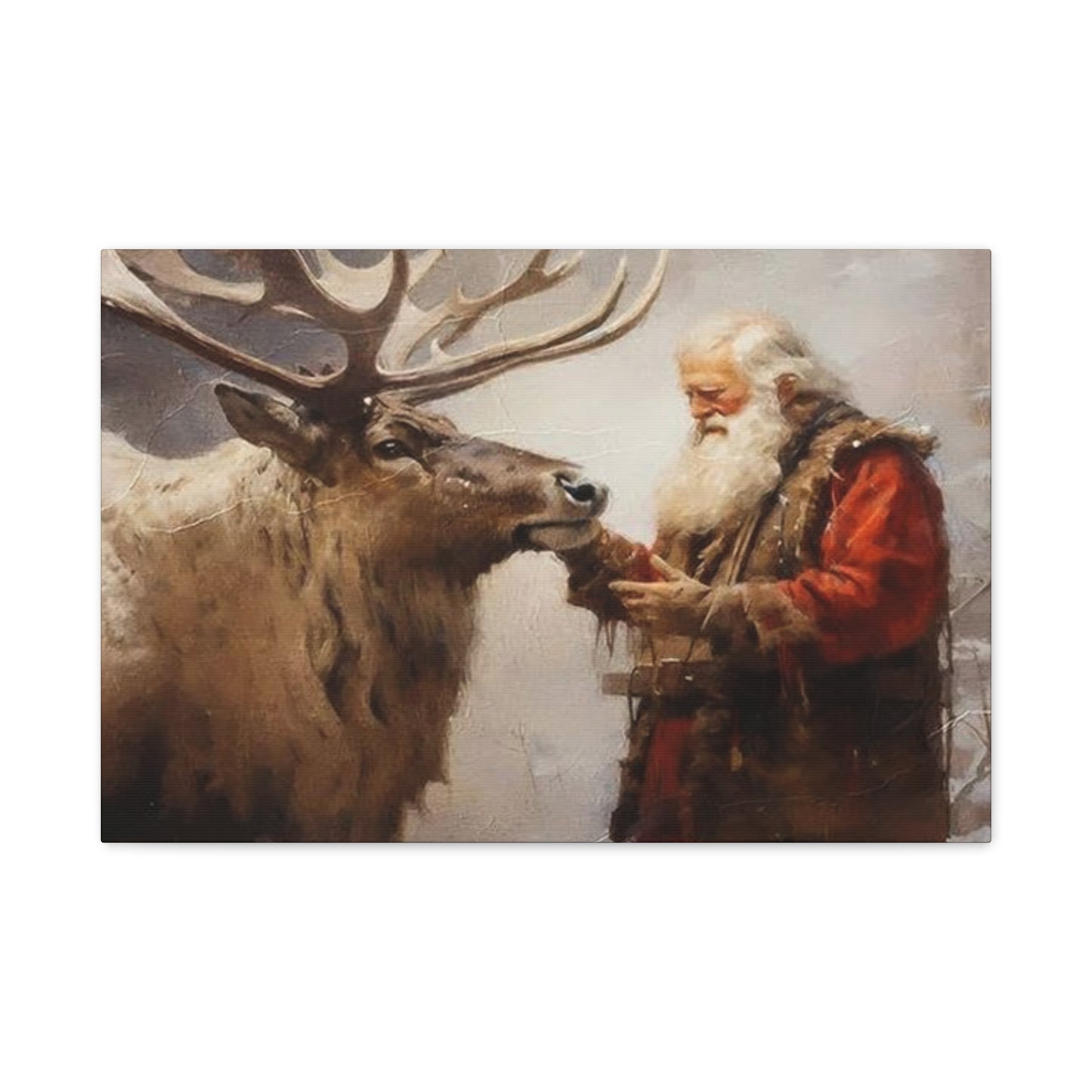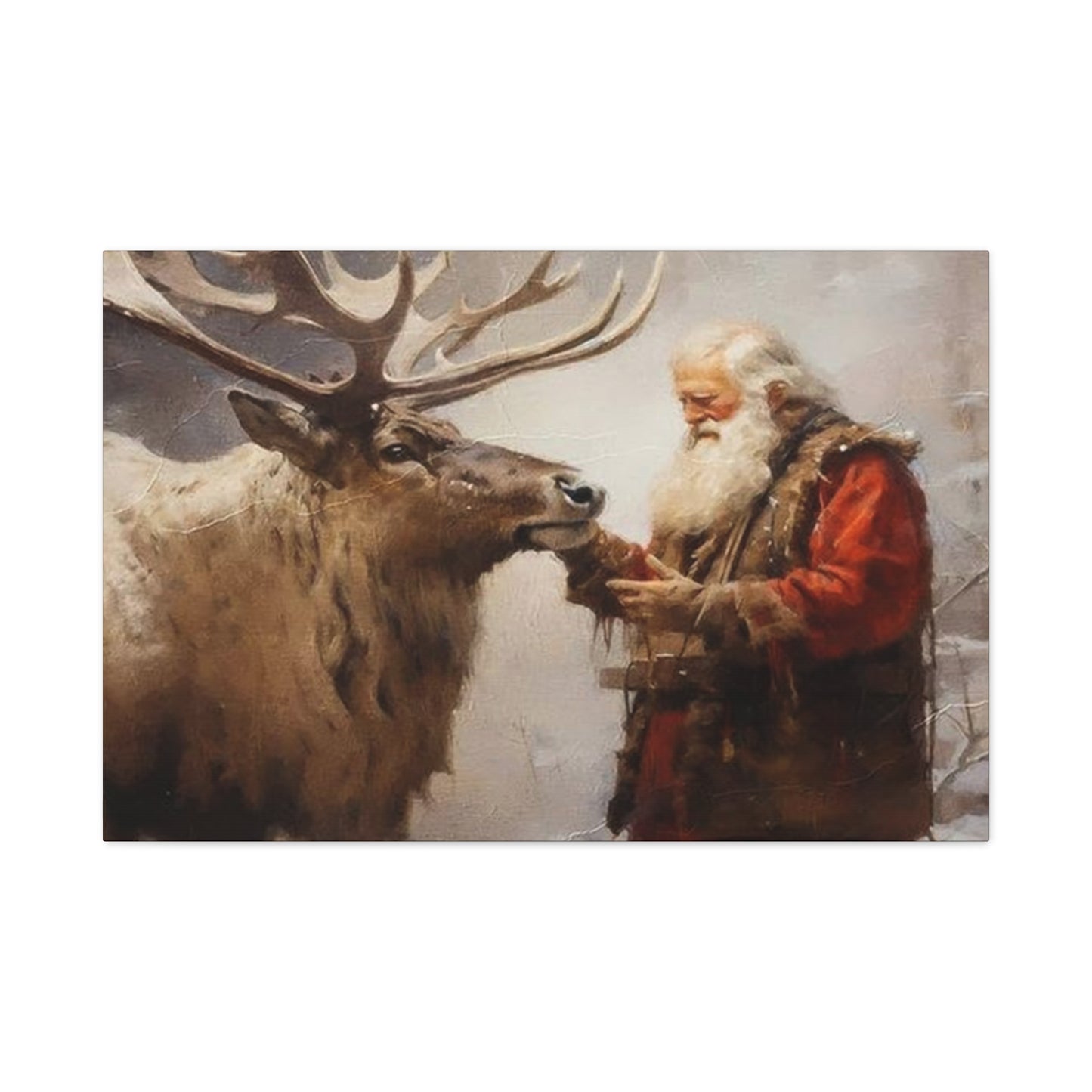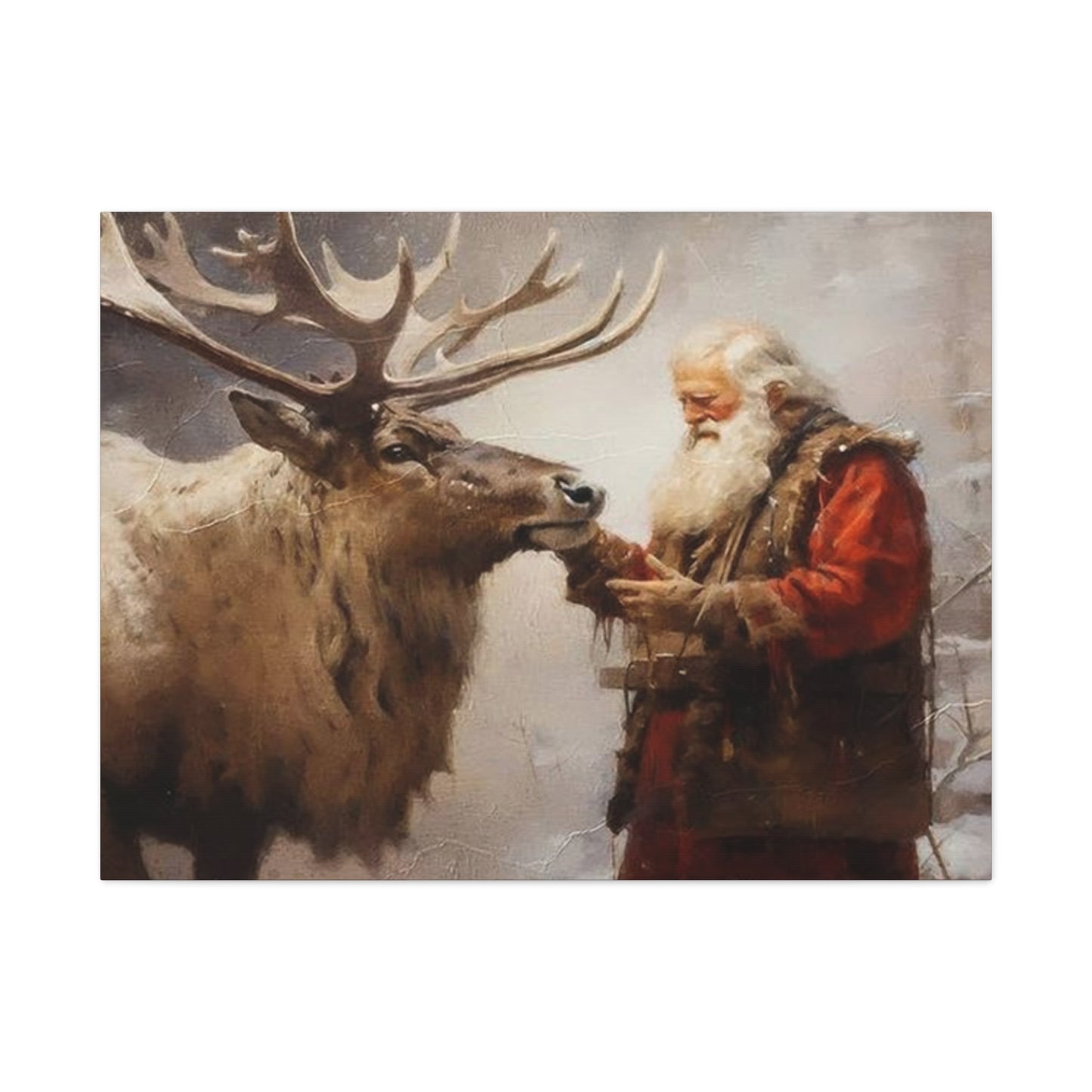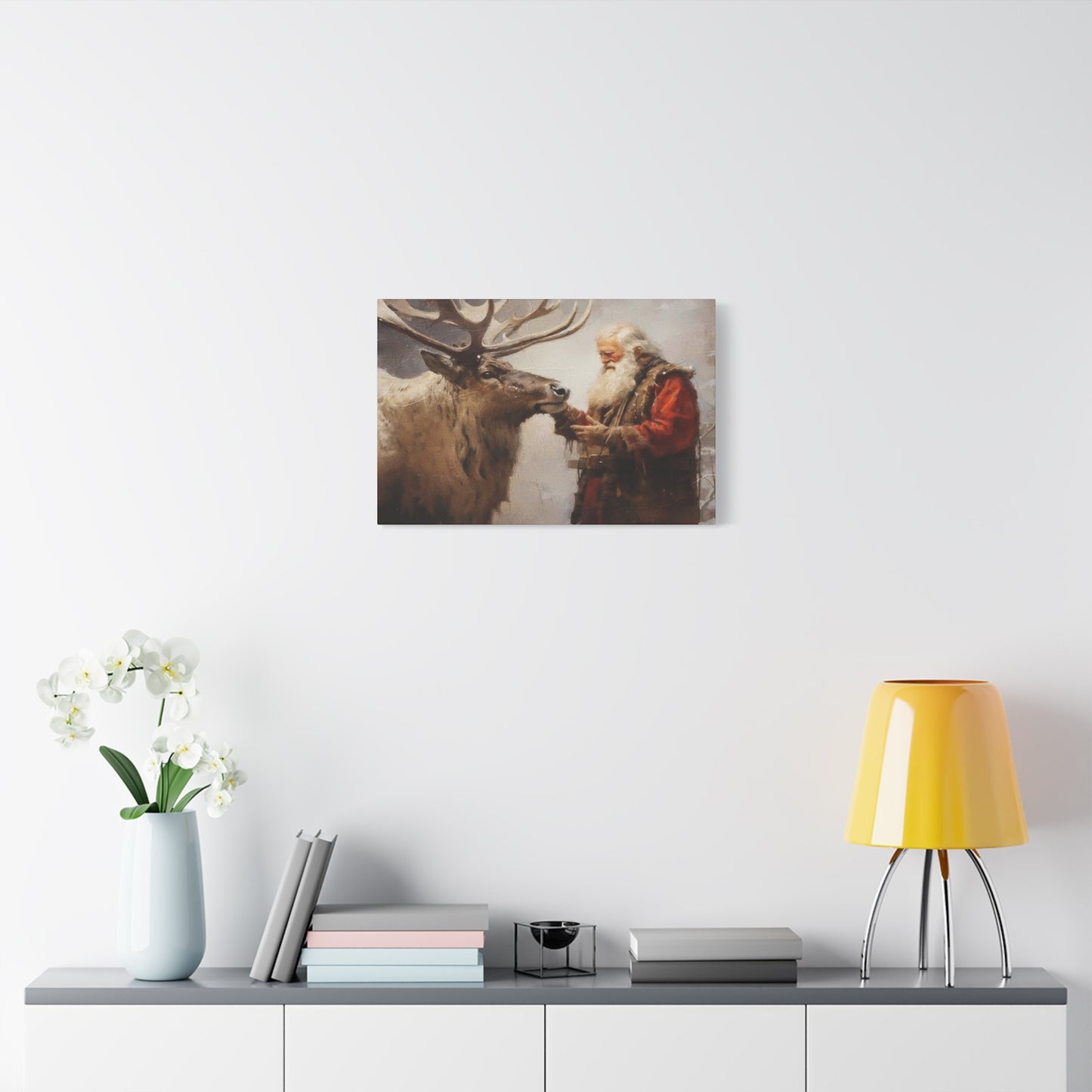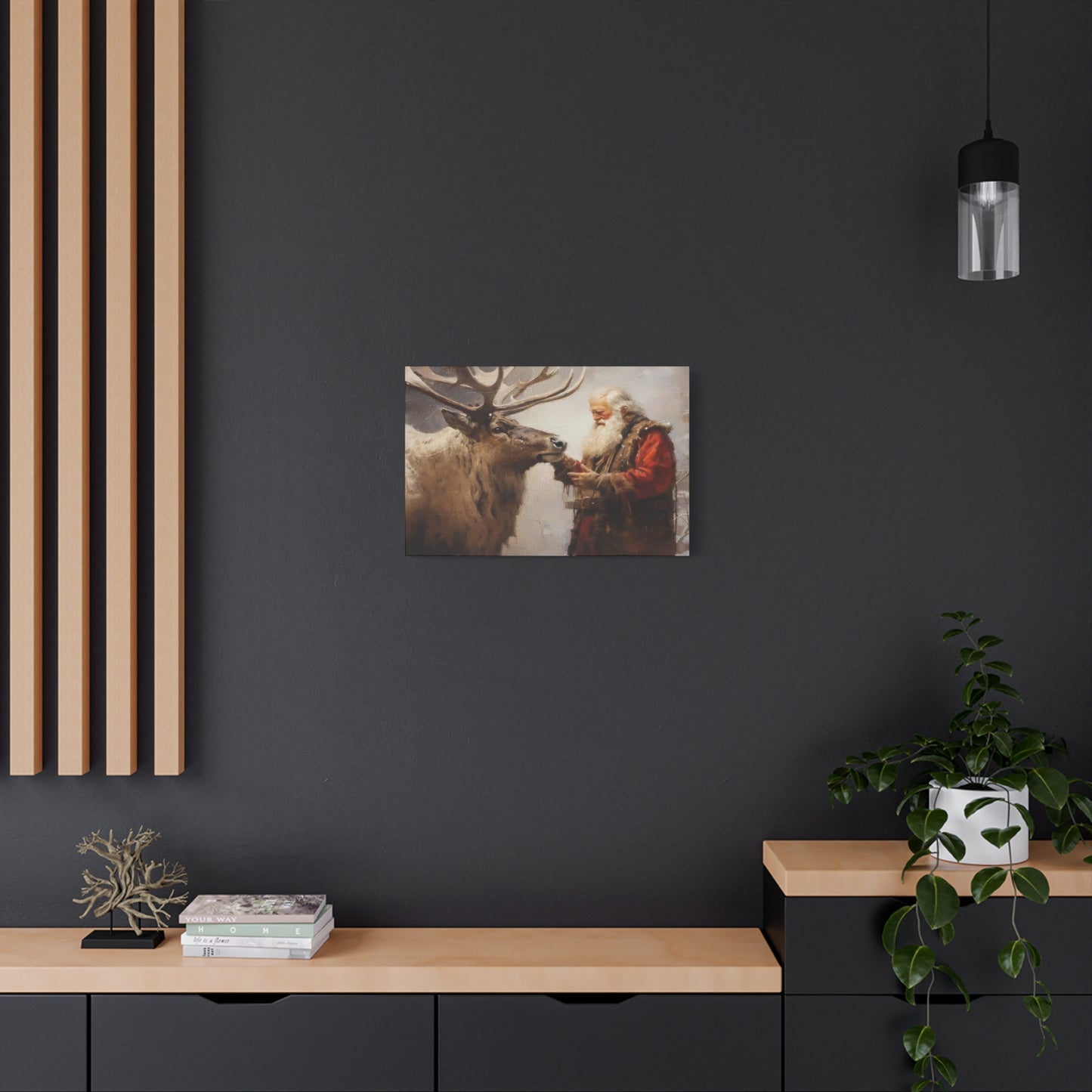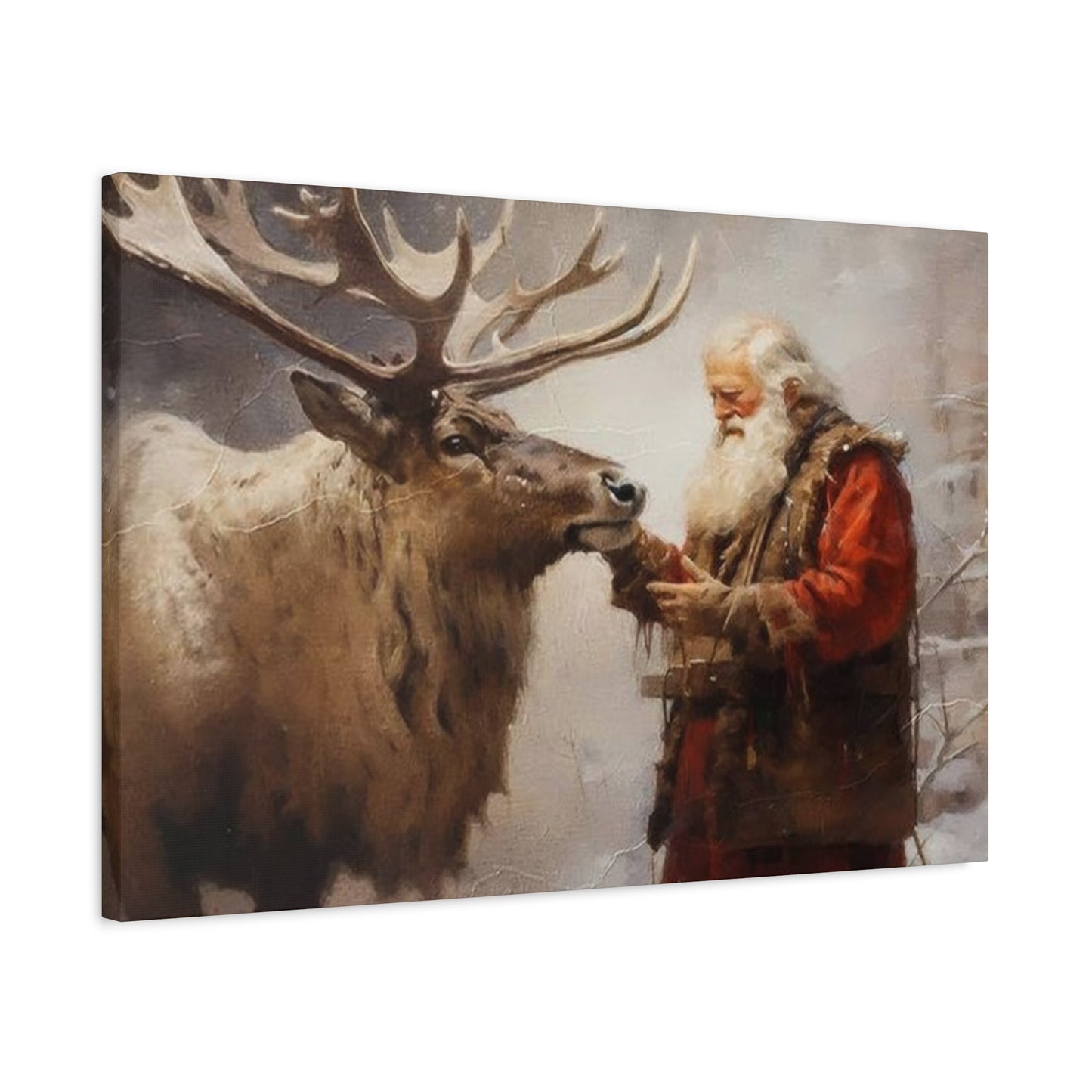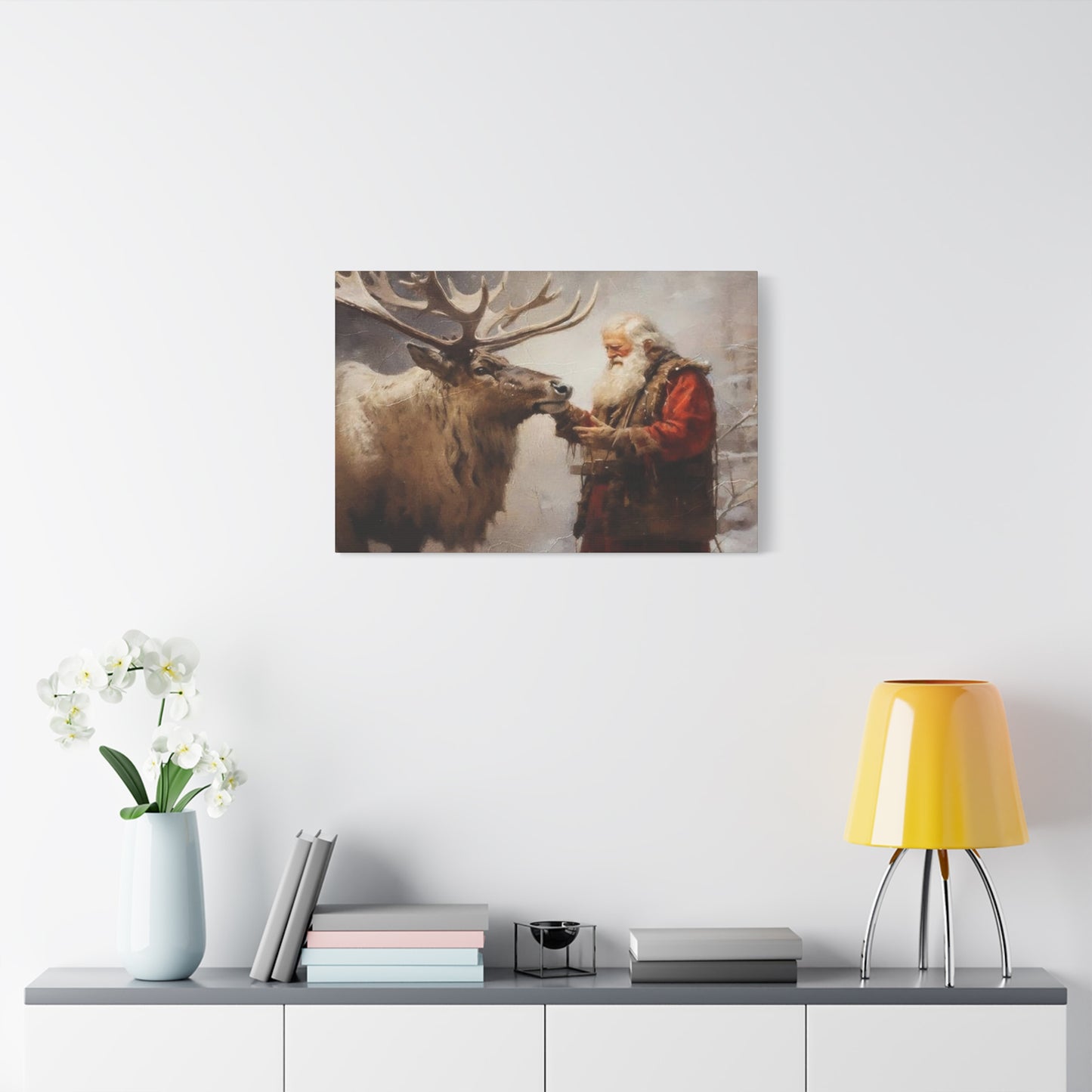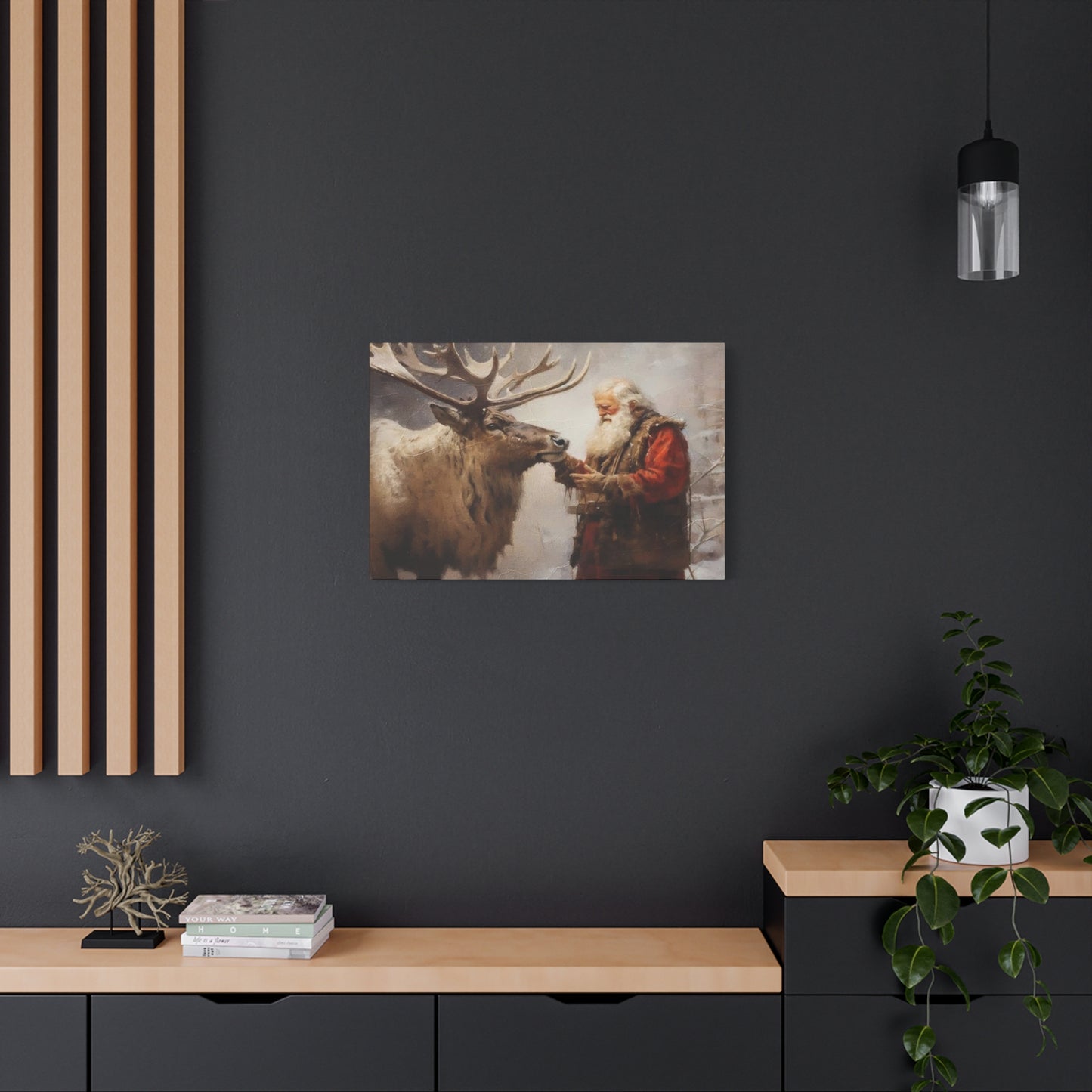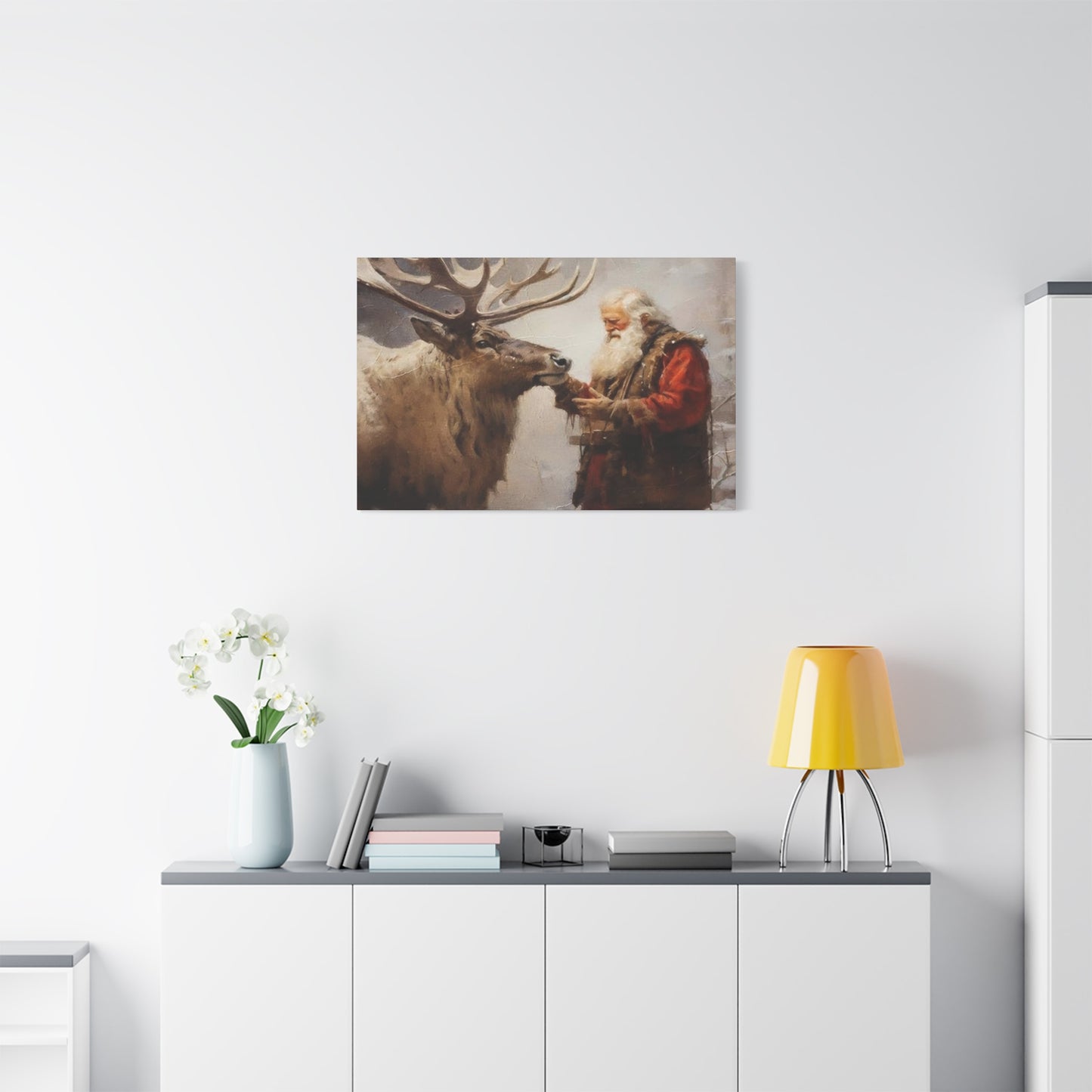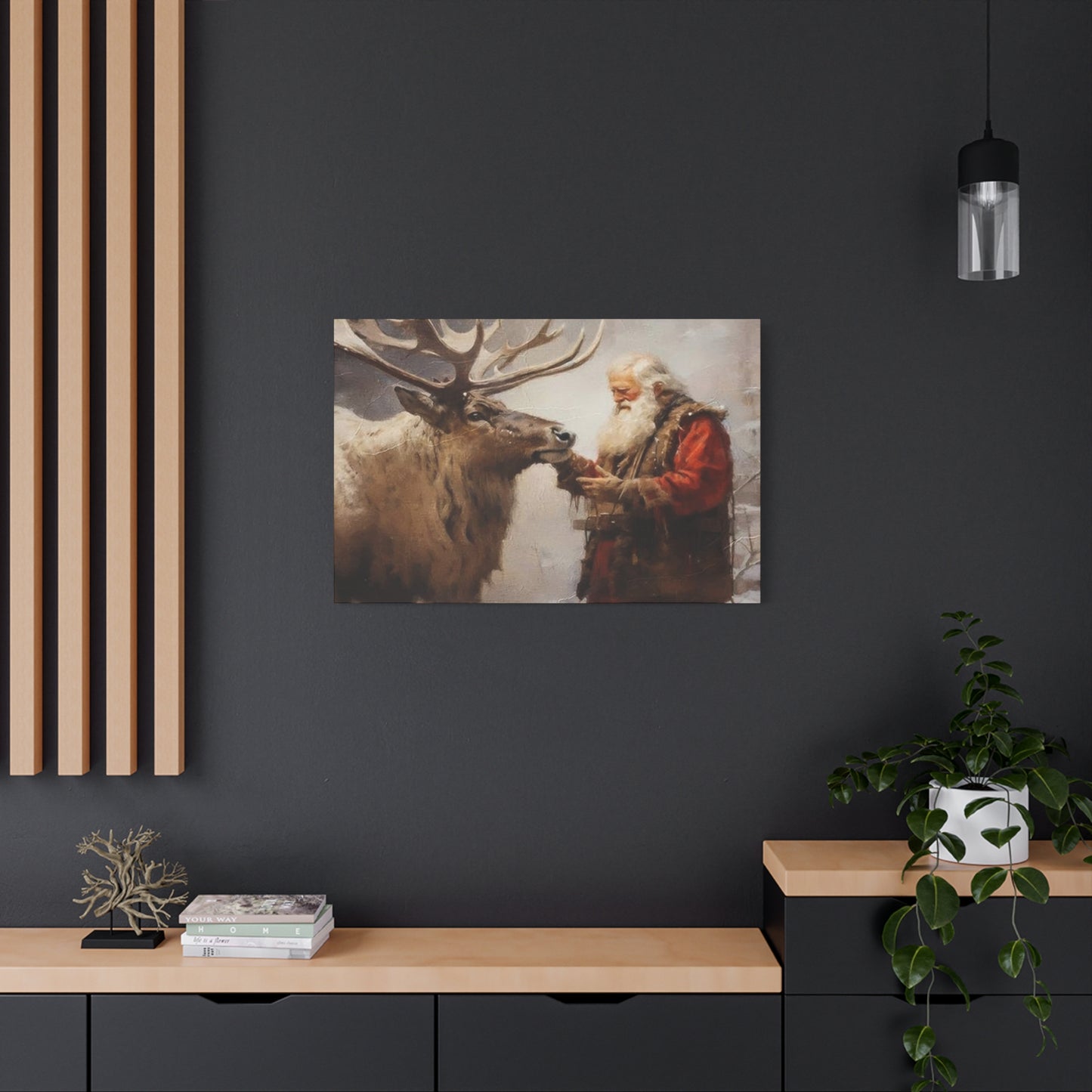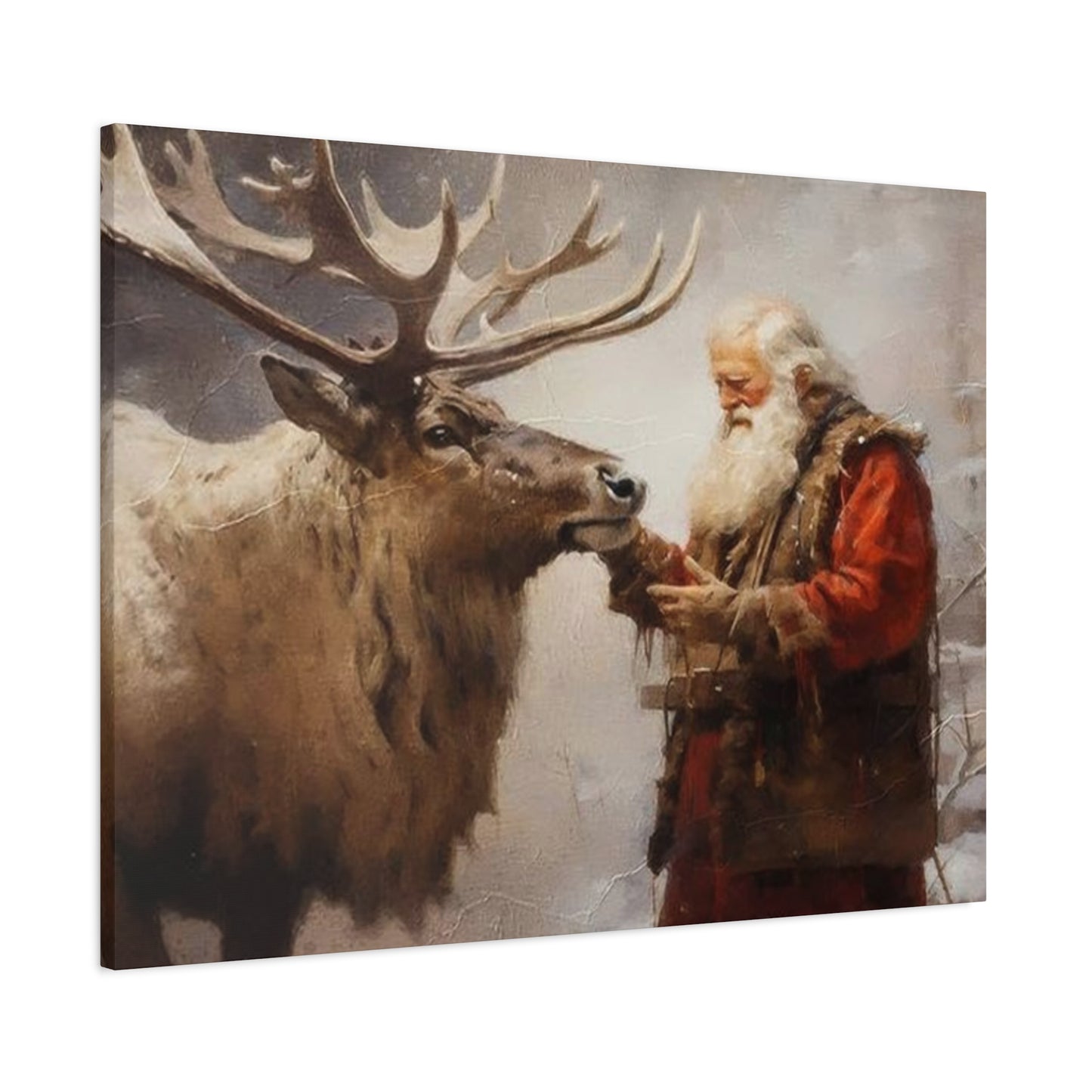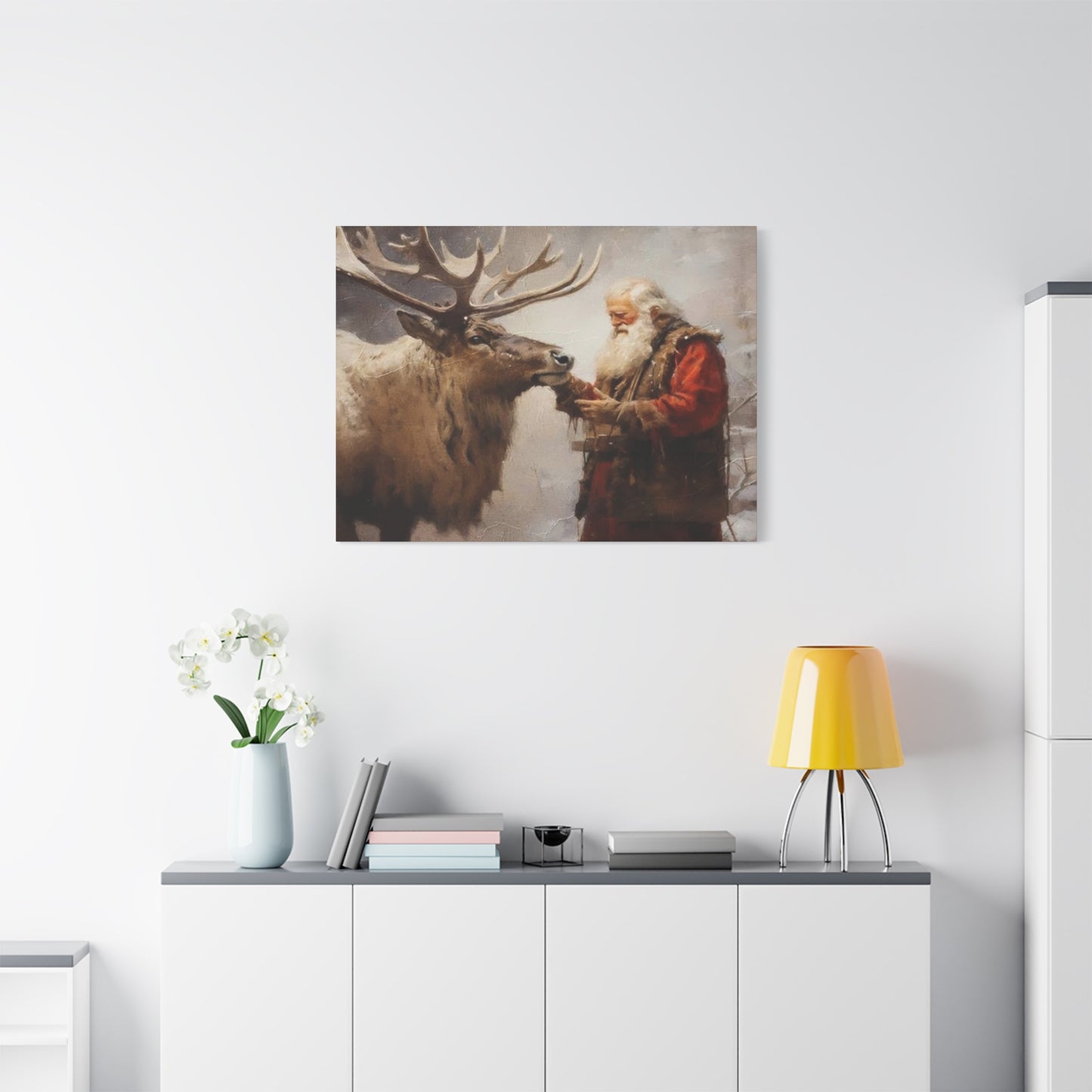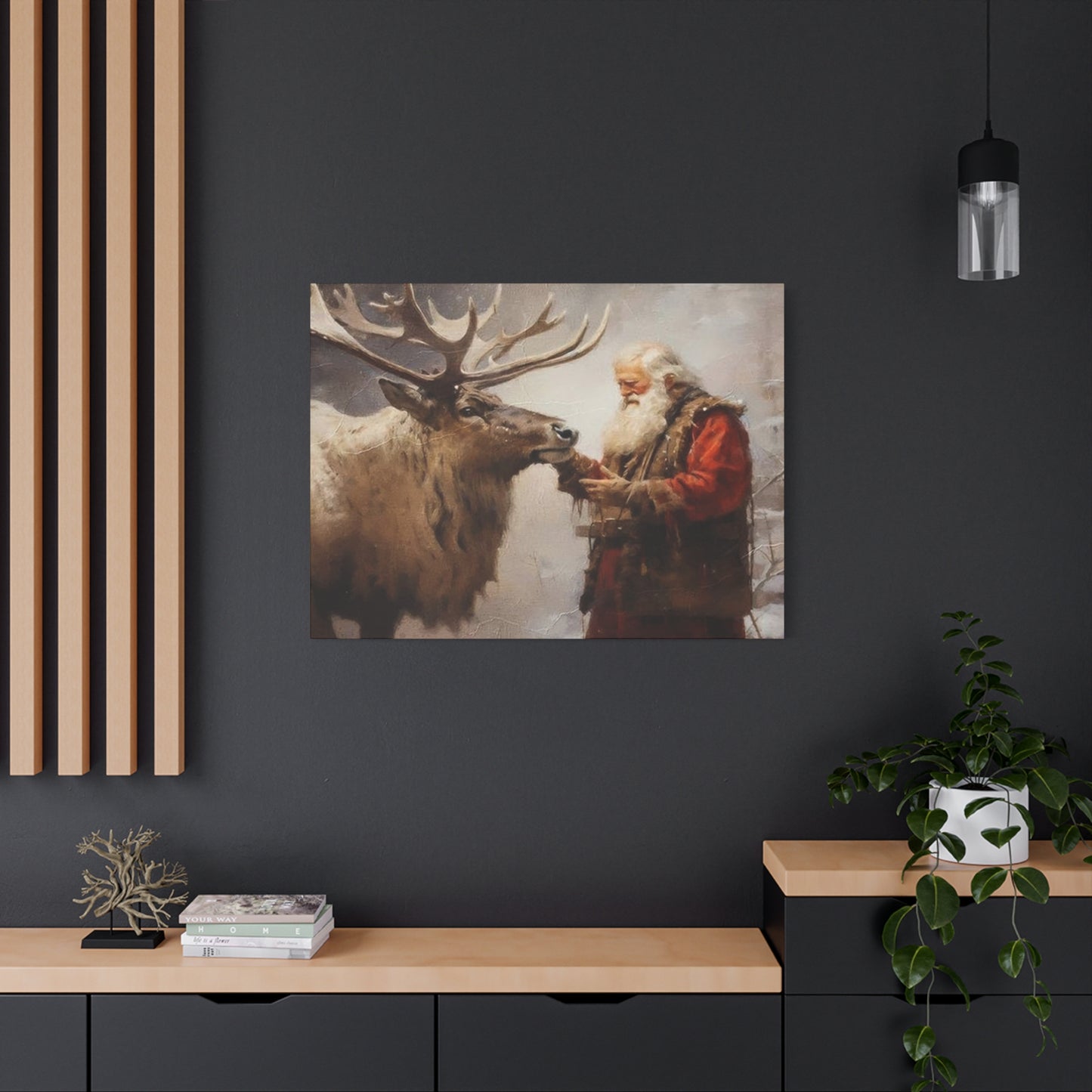Bringing Christmas to Life: Santa Claus with Reindeer Wall Art for Festive Homes
Nothing embodies the magic of the holiday season quite like the image of Santa Claus and his loyal reindeer soaring through the winter sky. Decorating with Santa and reindeer wall art instantly transforms any home into a joyful, festive haven, filling each room with nostalgia, warmth, and cheer. These timeless scenes celebrate the spirit of giving, imagination, and childhood wonder — making them perfect for both traditional and contemporary interiors. Whether rendered in classic oil paintings, whimsical illustrations, or modern digital prints, Santa-and-reindeer artwork offers a delightful way to bring Christmas to life.
The appeal of this festive wall art lies in its storytelling power. Each piece captures a moment of holiday magic — Santa loading his sleigh, guiding his reindeer through a snowy night, or delivering gifts beneath twinkling stars. These heartwarming images evoke the excitement of Christmas Eve and the joy of anticipation that defines the season. Homeowners often choose such artwork not only for its beauty but also for the emotional resonance it brings, reminding families of cherished traditions and the simple happiness of the holidays.
In terms of design, Santa and reindeer wall art can be adapted to suit any décor style. Vintage-inspired prints with muted tones and soft brushstrokes create a nostalgic, old-world charm, ideal for rustic or farmhouse-style homes. Meanwhile, contemporary renditions featuring vibrant colors or minimalist silhouettes pair beautifully with modern interiors. Framing choices — from distressed wood to sleek metallic finishes — further enhance the mood, allowing the artwork to harmonize seamlessly with existing holiday decorations.
The Timeless Appeal of Holiday-Themed Canvas Artwork
The tradition of displaying seasonal artwork in homes dates back centuries, with families seeking ways to commemorate special times of the year through visual storytelling. Canvas prints featuring jolly gift-givers and their animal helpers represent more than mere decoration; they embody cherished memories, family traditions, and the magical atmosphere that defines the winter holiday season. These artistic pieces serve as focal points in rooms, drawing eyes and sparking conversations about favorite traditions and childhood memories.
The enduring popularity of these decorative pieces stems from their ability to evoke powerful emotional responses. When you display artwork showing the legendary figure in his red suit alongside majestic caribou, you create an instant connection to beloved stories passed down through generations. This type of wall décor transcends simple aesthetics, becoming a meaningful expression of values like generosity, wonder, and family togetherness. The visual impact of such artwork can transform ordinary spaces into enchanted environments where imagination flourishes and holiday spirit thrives.
Contemporary homeowners appreciate how canvas prints offer superior quality compared to traditional paper posters. The texture and depth provided by canvas material create a museum-quality appearance that elevates any room's sophistication. Unlike flimsy alternatives, canvas prints mounted on sturdy frames maintain their visual integrity for years, resisting warping, fading, and damage from environmental factors. This durability makes them valuable investments that can become treasured family heirlooms, displayed proudly season after season.
Understanding Different Artistic Styles for Festive Canvas Prints
Artists employ various techniques and styles when creating representations of the beloved winter gift-bringer and his trusty team. Understanding these different approaches helps you select pieces that perfectly complement your existing décor while expressing your personal aesthetic preferences. From realistic portrayals to whimsical interpretations, the range of available styles ensures every homeowner can find artwork that resonates with their vision.
Traditional realistic styles capture the legendary figure with meticulous attention to detail, showcasing the texture of his famous red coat, the gleam in his eyes, and the powerful musculature of his antlered companions. These pieces often feature rich color palettes with deep reds, forest greens, and warm golden tones that evoke classic holiday imagery. Realistic artwork appeals to those who appreciate technical skill and want their wall décor to showcase the majesty and grandeur of this timeless character and his remarkable animals.
Vintage-inspired artwork offers nostalgic charm by recreating the aesthetic of mid-century holiday cards and advertisements. These pieces typically feature softer color palettes with muted tones, sometimes incorporating aged or distressed effects that make them appear like treasured antiques. The artistic style often includes simplified forms and stylized proportions that harken back to earlier eras when holiday imagery had a distinctly different character. Collectors and enthusiasts of retro décor particularly appreciate these pieces for their ability to evoke memories of simpler times.
Modern interpretations bring contemporary sensibilities to traditional subject matter, often employing bold color choices, geometric patterns, or abstract elements. Some artists create minimalist versions using simple lines and limited color palettes, while others experiment with surrealistic approaches that reimagine familiar scenes in unexpected ways. These innovative styles appeal to homeowners with eclectic tastes who want holiday décor that feels fresh and current while still honoring beloved traditions.
Watercolor-style prints offer soft, dreamy interpretations characterized by flowing colors and delicate blending. The gentle aesthetic of watercolor artwork creates peaceful, contemplative atmospheres perfect for bedrooms or quiet reading spaces. These pieces often feature ethereal backgrounds with swirling blues and purples representing night skies, with the main subjects rendered in slightly translucent layers that give them an almost magical quality.
Selecting the Perfect Size for Your Space
Choosing appropriate dimensions for your canvas artwork significantly impacts its visual effectiveness and how well it integrates into your room's design. Size selection requires careful consideration of wall space, viewing distance, furniture placement, and overall room proportions. A properly sized piece commands attention without overwhelming the space or appearing insignificant against vast empty walls.
For large living rooms with high ceilings and substantial wall space, oversized canvas prints measuring five feet wide or larger create dramatic focal points that anchor the room's design. These impressive pieces work particularly well above sofas, fireplaces, or console tables where they can be viewed from comfortable distances. The substantial scale of such artwork makes bold statements and demonstrates your commitment to creating truly festive environments. When hanging oversized pieces, ensure they span at least two-thirds of the furniture width beneath them to maintain visual balance.
Medium-sized prints ranging from three to four feet wide offer versatility for various spaces including dining rooms, family rooms, and master bedrooms. These dimensions provide substantial visual impact without requiring enormous expanses of wall space. Medium prints work beautifully as standalone pieces or as central elements in gallery wall arrangements. They offer enough detail to be appreciated up close while remaining visually coherent from across the room.
Smaller canvas prints measuring two feet wide or less excel in intimate spaces like hallways, bathrooms, powder rooms, and home offices. These compact pieces add festive touches to areas that might otherwise be overlooked during seasonal decorating. Multiple small prints can be arranged in creative configurations to fill larger walls while maintaining an organized, intentional appearance. The smaller scale also makes these pieces perfect for gift-giving, allowing friends and family to enjoy festive artwork without requiring significant wall commitments.
When determining ideal sizing, measure your available wall space carefully and use painter's tape to outline potential artwork dimensions directly on the wall. Step back and view the outlined area from multiple angles and distances to ensure it feels proportionally appropriate. Remember that artwork should have adequate breathing room, with several inches of empty wall space surrounding all edges to prevent cramped, cluttered appearances.
Color Schemes That Enhance Your Interior Design
The color palette of your chosen canvas print plays a crucial role in determining how successfully it integrates with your existing décor. Understanding color theory and how different hues interact helps you select pieces that enhance rather than clash with your carefully curated interior design. Thoughtful color coordination creates harmonious spaces that feel intentionally designed rather than haphazardly decorated.
Traditional holiday color schemes featuring rich reds, deep greens, and bright whites remain perennially popular for good reason. These classic combinations instantly evoke festive feelings and pair beautifully with traditional furniture styles, wood finishes, and conventional holiday decorations. Canvas prints utilizing these timeless colors work particularly well in homes with traditional or transitional design aesthetics. The warmth of red tones energizes spaces while green provides natural, grounding elements that balance the composition.
Blue and silver color schemes offer sophisticated alternatives to traditional palettes, creating elegant, winter wonderland atmospheres. Cool tones evoke icy landscapes and starlit skies, bringing serene, peaceful qualities to rooms. These color combinations work exceptionally well in contemporary or coastal-inspired interiors where cooler palettes dominate. Silver metallic accents add glamorous sparkle that catches light beautifully, creating dynamic visual interest as illumination changes throughout the day.
Neutral color schemes featuring browns, tans, creams, and soft grays provide understated elegance that appeals to minimalist sensibilities. Canvas prints using muted, natural tones blend seamlessly with Scandinavian, farmhouse, and rustic décor styles. These subtle pieces allow the subject matter itself to shine without competing color distractions. Neutral artwork also offers greater longevity since you can display these pieces year-round without them feeling seasonally specific.
For those who embrace bold, eclectic design, multicolored prints featuring vibrant, unexpected color combinations make exciting statements. Jewel tones like emerald, sapphire, ruby, and amethyst create luxurious, richly saturated compositions that demand attention. These daring choices work well in maximalist interiors or as intentional contrast elements in otherwise neutral spaces. The key to successfully incorporating bold colored artwork lies in repeating those colors in smaller doses throughout the room via accessories, textiles, or accent furniture.
Creating Gallery Walls with Multiple Canvas Pieces
Gallery walls featuring multiple coordinated canvas prints offer dynamic, visually engaging alternatives to single large artworks. These curated collections allow you to tell more complex visual stories while filling substantial wall space with organized, intentional arrangements. Successful gallery walls require careful planning regarding piece selection, arrangement patterns, and installation techniques.
Symmetrical gallery walls feature balanced arrangements with pieces positioned in organized grids or geometric patterns. This formal approach suits traditional interiors and provides predictable, orderly visual rhythms. Symmetrical arrangements typically work best with prints of identical or closely related sizes, creating uniform appearances with consistent spacing between all pieces. The structured nature of symmetrical galleries conveys sophistication and careful attention to design details.
Asymmetrical gallery walls embrace organic, free-form arrangements that feel more casual and contemporary. These collections often incorporate various sizes mixed together in intentionally unbalanced configurations that still maintain overall visual equilibrium. Asymmetrical arrangements allow greater creative freedom and can accommodate diverse artwork styles within single displays. The key to successful asymmetric galleries lies in maintaining consistent spacing between all pieces while ensuring the overall composition feels anchored and intentional rather than chaotic.
Thematic gallery walls unite multiple pieces through shared subject matter, color palettes, or artistic styles. You might create a collection showing the legendary figure in various poses and settings, or combine portraits of individual caribou with scene-setting landscape pieces. Thematic coherence helps diverse pieces feel like intentional collections rather than random assortments. This approach works particularly well when you want to create immersive themed environments in children's rooms or dedicated holiday spaces.
Before committing holes to walls, arrange all pieces on the floor in your planned configuration. Photograph the layout from above and refer to this image during installation. Create paper templates matching each piece's dimensions and tape these templates to the wall to visualize the final arrangement before hanging. This planning prevents installation mistakes and ensures optimal spacing and alignment.
Placement Strategies for Maximum Visual Impact
Strategic placement of canvas artwork dramatically affects its visual impact and how successfully it enhances your space. Understanding principles of interior design and considering practical factors like lighting, traffic flow, and viewing angles helps you position artwork for optimal effect. Thoughtful placement transforms good artwork into stunning focal points that elevate entire rooms.
Eye-level hanging represents the gold standard for artwork placement, positioning the piece's center approximately 57 to 60 inches from the floor. This height reflects average human eye level when standing, ensuring comfortable viewing without strain. In rooms where people predominantly sit, consider lowering artwork slightly to maintain comfortable sight lines from seated positions. The eye-level principle applies regardless of ceiling height, preventing the common mistake of hanging artwork too high.
Above furniture placement requires careful attention to maintain proper proportions and visual relationships. When hanging artwork above sofas, beds, or console tables, position the bottom edge approximately 6 to 12 inches above the furniture's top. The artwork should span at least two-thirds of the furniture's width to appear substantial and anchored rather than floating awkwardly. Centering the piece horizontally over the furniture creates balanced, harmonious arrangements.
Lighting considerations significantly impact how artwork appears throughout the day and evening. Natural light from windows illuminates canvas prints beautifully during daylight hours but can cause fading over time if direct sunlight strikes the artwork. Position pieces perpendicular to windows rather than directly opposite them to minimize sun exposure while maintaining ambient illumination. For evening viewing, install dedicated picture lights or position existing light fixtures to properly illuminate artwork without creating harsh glares or shadows.
Room function influences optimal artwork placement and subject matter selection. High-energy spaces like kitchens and family rooms benefit from dynamic, colorful pieces that energize and uplift. Bedrooms call for calmer, more serene artwork that promotes relaxation. Hallways and entryways offer opportunities to create welcoming first impressions with artwork that reflects your personal style and sets tones for adjacent spaces.
Incorporating Canvas Prints into Various Room Designs
Different rooms present unique opportunities and challenges for displaying festive canvas artwork. Understanding how to adapt your decorative approach to suit each space's specific characteristics ensures cohesive, harmonious results throughout your home. Thoughtful integration of artwork enhances existing design elements while adding seasonal charm.
Living rooms serve as primary gathering spaces where families spend significant time together, making them ideal locations for substantial, impressive canvas pieces. Large-scale artwork above mantels or behind sofas creates commanding focal points that anchor the room's entire design. Living rooms typically accommodate bolder colors and more detailed compositions since viewers have opportunities to appreciate intricate details from comfortable seating positions. Consider the viewing distance from primary seating when selecting artwork size and detail level.
Dining rooms benefit from artwork that enhances mealtime atmospheres without overwhelming the space or competing with table settings. Medium-sized pieces positioned on walls opposite or adjacent to dining tables work beautifully, providing visual interest for diners without dominating the space. Dining room artwork should complement your preferred entertaining style, whether formal and traditional or casual and eclectic. The festive nature of holiday-themed prints makes them particularly appropriate for dining spaces where families gather to share special meals.
Bedrooms require careful consideration since artwork significantly impacts the room's emotional atmosphere and your ability to relax. Peaceful, calming interpretations work better than highly energetic or intensely colored pieces in spaces dedicated to rest. Position bedroom artwork where you'll see it regularly, such as on walls opposite the bed or above headboards. The personal, private nature of bedrooms allows you to choose pieces with special sentimental meaning even if they don't perfectly match your public space aesthetic.
Seasonal Decorating Strategies with Canvas Artwork
Canvas prints featuring holiday imagery offer flexible decorating options that can be adapted to various seasonal display strategies. Understanding different approaches to seasonal decorating helps you determine how to incorporate festive artwork in ways that align with your lifestyle, storage capabilities, and decorating preferences. The right strategy makes seasonal transitions feel effortless rather than burdensome.
Dedicated seasonal rotation involves storing festive artwork during off-seasons and displaying it only during appropriate months. This traditional approach maintains the special, anticipated quality of holiday decorations, ensuring they never feel commonplace or lose their emotional impact. Properly storing canvas prints protects them from damage while keeping storage areas organized. Use protective covers or boxes that prevent dust accumulation, and store prints flat or upright rather than leaning them at angles that could cause warping.
Year-round display with strategic styling allows you to keep favorite pieces visible throughout all seasons by carefully coordinating surrounding décor. Artwork featuring subtle, sophisticated interpretations in neutral color palettes can remain displayed perpetually when you style adjacent spaces seasonally. During off-seasons, remove obviously seasonal accessories while maintaining the canvas prints, allowing them to blend more neutrally into general décor. This approach works particularly well for vintage or artistic interpretations that function as general wall art beyond their seasonal associations.
Layered decorating involves displaying multiple pieces in the same location at different times, with festive prints layered over more neutral year-round artwork during appropriate seasons. Removable hanging systems make this approach practical, allowing quick seasonal transitions without creating new wall holes. The layering strategy works beautifully for renters or those who change décor frequently, providing maximum flexibility with minimal commitment.
Gradual transition decorating spreads seasonal decorating across several weeks, slowly introducing festive elements beginning in early autumn and maintaining them through winter. Canvas prints might appear in early phases of this gradual shift, establishing holiday foundations that you build upon with additional decorations. This approach prevents the overwhelming all-at-once decorating sessions that many people find exhausting while creating extended periods of seasonal enjoyment.
Maintenance and Care for Canvas Artwork
Proper maintenance ensures your canvas prints remain beautiful for years, protecting your investment while preserving cherished decorative pieces. Understanding appropriate cleaning techniques and preventive care practices helps you avoid common mistakes that can damage artwork irreversibly. Regular attention keeps prints looking fresh and vibrant throughout countless display seasons.
Dusting represents the most frequent maintenance task for canvas artwork. Use soft, clean microfiber cloths or specialized dusting tools designed for delicate surfaces. Gently wipe the canvas surface with light pressure, working from top to bottom to avoid redistributing dust. Avoid feather dusters that can catch on canvas textures and potentially cause damage. Establish regular dusting schedules, perhaps monthly or whenever you notice visible dust accumulation.
For more thorough cleaning, slightly dampen a clean microfiber cloth with water and gently wipe the canvas surface. Never saturate the cloth or apply liquid directly to canvas, as excess moisture can damage both the canvas material and the printed image. Work in small sections using gentle circular motions, then immediately dry each area with a separate clean cloth. Only clean canvas prints when absolutely necessary, as frequent wet cleaning can gradually degrade protective coatings.
Avoid harsh chemicals, cleaning solutions, or abrasive materials that can permanently damage canvas prints. Standard household cleaners often contain ingredients that dissolve or discolor printed inks. Even gentle cleaners may react unpredictably with various canvas treatments and coatings. When in doubt, test any cleaning method on a small, inconspicuous area first, or consult professional art conservators for guidance on addressing stubborn stains or damage.
Custom Canvas Print Options and Personalization
Custom canvas printing services offer opportunities to create truly unique pieces tailored precisely to your preferences and requirements. Understanding available customization options empowers you to design artwork that perfectly reflects your vision while addressing specific spatial and aesthetic needs. Personalized pieces often become treasured family heirlooms with special sentimental value.
Photographic personalization allows you to incorporate family photos into festive artwork compositions. Imagine canvas prints featuring your children's faces superimposed onto traditional scenes, or family photos framed by decorative holiday borders and embellishments. These personalized pieces celebrate your unique family while maintaining festive aesthetics. Many printing services offer templates and design tools that simplify the customization process, guiding you through various options and previewing results before ordering.
Text customization adds names, dates, meaningful quotes, or family mottos to canvas artwork, increasing personal significance. Including family surnames or establishment dates transforms generic festive prints into custom family heirlooms. Inspirational holiday quotes or favorite song lyrics add layers of meaning that resonate with your family's values and traditions. Consider typography carefully, choosing fonts that complement the artwork's overall style while remaining easily readable.
Color customization allows you to request specific color palette adjustments that perfectly match your existing décor. If you love a particular design but prefer different colors, many custom printers can adjust hues to your specifications. This service ensures seamless integration with your carefully curated interior design while maintaining the composition and style you admire.
Size customization addresses unique spatial requirements that standard sizes cannot accommodate. Whether you need to fill an awkwardly proportioned wall space or want to match specific furniture dimensions precisely, custom sizing ensures perfect fits. Provide exact measurements to printing services and discuss how your requested dimensions might affect image composition and detail visibility.
Budget-Friendly Options for Quality Canvas Prints
Beautiful festive canvas artwork need not strain your budget when you understand how to identify quality pieces at various price points. Smart shopping strategies and timing help you acquire impressive artwork while maintaining financial responsibility. Quality and affordability can coexist when you approach purchasing decisions strategically.
End-of-season sales offer exceptional opportunities to acquire premium canvas prints at dramatically reduced prices. Retailers typically discount seasonal inventory heavily in January and February to clear space for spring merchandise. Patient shoppers who plan ahead can build impressive collections by purchasing prints at deep discounts for display in subsequent seasons. Mark calendars for these predictable sale periods and monitor favorite retailers for clearance announcements.
Online marketplaces provide access to thousands of independent artists and small manufacturers offering competitive pricing without traditional retail markups. The direct-to-consumer model eliminates middleman costs, passing savings to buyers. However, carefully evaluate seller reputations, read customer reviews, and understand return policies before purchasing. Request detailed photos showing actual product examples rather than relying solely on digital mockups that may not accurately represent final quality.
Print-on-demand services allow you to transform digital images into canvas prints affordably, particularly when ordering during promotional periods. These services frequently offer discount codes, seasonal promotions, and bulk order savings. Compare prices across multiple providers since costs can vary significantly for identical specifications. Remember that lowest prices don't always represent best values if quality suffers significantly.
DIY canvas printing represents the ultimate budget-friendly option for crafty individuals with basic technical skills. Purchase blank pre-stretched canvases, print designs on specialty fabric paper using home printers, and adhere the printed fabric to canvas using appropriate adhesives. While this approach requires time investment and produces less durable results than professional printing, it allows unlimited customization at minimal cost. Numerous online tutorials provide step-by-step instructions for various DIY canvas printing techniques.
Combining Traditional and Modern Design Elements
Successfully blending traditional holiday imagery with contemporary design sensibilities creates unique, personalized aesthetics that feel fresh yet familiar. This balanced approach honors cherished traditions while reflecting current design trends and personal style preferences. Understanding how to marry seemingly disparate elements produces sophisticated results that transcend fleeting trends.
Traditional subject matter rendered in modern artistic styles bridges classic and contemporary aesthetics beautifully. Imagine familiar scenes reimagined through minimalist interpretations using simple lines and limited color palettes, or realistic portrayals presented with abstract backgrounds. These hybrid approaches satisfy nostalgia for classic imagery while appealing to modern design preferences. The familiar subject matter provides immediate recognition and emotional connection, while contemporary execution prevents dated or overly sentimental appearances.
Color palette selection offers powerful tools for modernizing traditional imagery. Replacing conventional reds and greens with sophisticated alternatives like navy, blush, copper, and sage creates contemporary feels while maintaining festive associations. Monochromatic color schemes in shades of single hues produce striking modern impacts while simplifying integration with existing décor. Unexpected color choices signal design confidence and creativity, distinguishing your decorative choices from conventional approaches.
Mixing artwork styles within single spaces demonstrates design sophistication when executed thoughtfully. Pair traditional festive canvas prints with abstract modern pieces, creating intentional contrasts that highlight each style's unique qualities. Ensure connecting elements like shared colors, similar scales, or coordinating frames unite disparate pieces into cohesive collections. This eclectic approach works particularly well in homes with transitional design aesthetics that already blend traditional and contemporary elements.
Furniture and accessory pairings significantly impact how traditional artwork reads within spaces. Displaying classic holiday canvas prints in rooms furnished with sleek modern pieces creates interesting tensions that feel dynamic rather than confused. Conversely, incorporating contemporary artwork into traditionally furnished spaces signals design awareness and prevents rooms from feeling like museum period displays. The key lies in maintaining intentionality, ensuring all elements feel purposefully selected rather than randomly assembled.
Lighting Techniques to Enhance Canvas Artwork
Proper lighting dramatically affects how canvas prints appear and how successfully they integrate into room designs. Strategic illumination enhances colors, reveals details, and creates dramatic effects that elevate artwork from simple wall décor to captivating focal points. Understanding lighting principles helps you showcase artwork optimally while creating beautiful ambient effects.
Natural lighting provides ideal illumination that renders colors accurately while creating dynamic effects as sunlight shifts throughout the day. Position artwork perpendicular to windows rather than directly opposite them to maximize ambient light while minimizing direct sun exposure that causes fading. Consider seasonal variations in natural light angles and intensity when positioning artwork. North-facing walls receive consistent indirect light throughout the day, making them excellent locations for artwork in northern hemisphere homes.
Picture lights mounted directly above or below artwork provide focused illumination that highlights pieces during evening hours. These dedicated fixtures come in various styles from traditional brass arms to modern LED strips. Adjustable picture lights allow you to direct light precisely, eliminating shadows and glare. Battery-operated or plug-in options provide installation flexibility for renters or situations where hardwiring proves impractical. Choose picture lights with color temperatures around 3000K that render colors naturally without harsh blue or yellow casts.
Track lighting offers flexible solutions for illuminating multiple artworks or allowing easy adjustment as you rearrange pieces. Individual track heads can be positioned and angled independently, providing customized lighting for each artwork. Modern track systems feature sleek profiles that virtually disappear against ceilings, eliminating the industrial appearance of older designs. Dimmable track systems let you adjust illumination intensity to suit different times and activities.
Accent lighting from table lamps, floor lamps, or sconces can effectively highlight nearby artwork when properly positioned. Place lamps where their light grazes artwork surfaces at appropriate angles, revealing textures while avoiding harsh glares. Lampshade selection affects light quality and direction, with opaque shades directing more light upward and downward while translucent shades create ambient glow. Experiment with lamp positions to find optimal arrangements that illuminate artwork beautifully.
Ambient room lighting affects how artwork appears even when not directly illuminated. Overhead fixtures, recessed lighting, and general room illumination establish baseline visibility and influence color perception. Use warm white bulbs rather than cool white options to create inviting atmospheres that complement festive artwork. Dimmer switches provide lighting control that allows you to adjust room ambiance for different occasions and times of day.
Creating Themed Rooms Around Canvas Artwork
Designing entire rooms around festive canvas prints creates immersive environments that fully embrace holiday magic and wonder. This ambitious decorating approach transforms ordinary spaces into extraordinary themed experiences that delight occupants and visitors. Understanding how to develop cohesive themes helps you create impressive results that feel professionally designed rather than haphazardly assembled.
Color extraction involves identifying prominent colors from your chosen canvas print and repeating those hues throughout the room via textiles, accessories, and accent pieces. This technique creates harmonious color stories that visually connect all elements. Use varying shades and tones of extracted colors rather than exact matches to add depth and interest while maintaining cohesion. Include both warm and cool tones to prevent spaces from feeling monotonous or one-dimensional.
Motif repetition reinforces themes by incorporating related imagery and patterns throughout the space. If your canvas print features specific elements like pine trees, snowflakes, or stars, echo those motifs in throw pillows, curtains, area rugs, and decorative accessories. Vary the scale and styling of repeated motifs to maintain interest while avoiding excessive repetition that feels overwhelming or juvenile. Subtle incorporation of themed elements feels sophisticated while obvious overuse appears heavy-handed.
Texture layering adds dimensional richness that prevents themed rooms from feeling flat or costume-like. Incorporate various materials including wood, metal, glass, fabric, and natural elements that relate to your theme. Rough-hewn woods and natural fibers suit rustic winter themes, while metallics and luxurious fabrics enhance elegant interpretations. Textural variety creates sensory interest that makes spaces feel professionally designed and intentionally curated.
Focal point emphasis ensures your canvas artwork maintains its starring role rather than competing equally with numerous other themed elements. Arrange furniture to orient toward your featured artwork, creating clear visual hierarchies. Keep areas immediately surrounding the canvas relatively simple, allowing the artwork to dominate its wall. Distribute other themed elements throughout the room rather than clustering everything around the canvas print, which would diminish its individual impact.
Pairing Canvas Prints with Complementary Décor Elements
Successfully integrating canvas artwork into broader decorating schemes requires thoughtful coordination with surrounding décor elements. Understanding how different decorative pieces interact helps you create cohesive environments where all elements work together harmoniously. Strategic pairing elevates individual pieces while strengthening overall design impact.
Throw pillows offer easy opportunities to echo colors and themes from canvas artwork. Select pillows featuring complementary hues, related patterns, or thematic imagery that connects with your canvas print. Mix solid colors with patterns in varying scales to create visual interest while maintaining cohesion. Position themed pillows on sofas and chairs within sight lines of your artwork to strengthen visual connections between elements.
Area rugs ground spaces while providing additional opportunities to reinforce color schemes and themes. Choose rugs featuring colors that appear in your canvas artwork, creating visual threads that tie the room together. Consider pattern scale carefully, ensuring rug designs complement rather than compete with artwork complexity. In smaller rooms, simpler rug patterns work better, while larger spaces can accommodate bolder designs.
Window treatments significantly impact room atmosphics while offering substantial opportunities for color and pattern coordination. Curtains or drapes incorporating colors from your canvas print create elegant visual continuity. Consider fabric texture and weight, with heavier materials feeling formal and luxurious while sheers appear light and casual. Coordinate curtain hardware finishes with frame colors or metallic accents in artwork for polished, intentional appearances.
Decorative accessories including vases, candles, figurines, and ornamental objects provide finishing touches that complete themed environments. These smaller elements allow you to incorporate multiple colors from canvas artwork without overwhelming spaces. Group accessories in odd numbers following the rule of three for most pleasing visual arrangements. Vary heights and sizes within groupings to create dynamic compositions rather than uniform lines.
Furniture selection or arrangement can enhance how successfully artwork integrates into spaces. Position key furniture pieces to frame views of artwork or create conversation areas that naturally orient toward featured prints. Furniture finishes and upholstery colors should coordinate with artwork palettes, though exact matching isn't necessary or even desirable. Complementary relationships feel more sophisticated than overly coordinated appearances.
The Role of Canvas Prints in Creating Holiday Traditions
Decorative choices often evolve into meaningful family traditions that children remember fondly and eventually recreate in their own homes. Canvas artwork featuring beloved holiday imagery can become central to family traditions and rituals that define your unique celebration style. Understanding how material objects facilitate tradition-building helps you make decorating choices that transcend mere aesthetics.
Annual unveiling ceremonies transform artwork display into anticipated events that mark seasonal transitions. Rather than casually hanging prints whenever convenient, create special moments around their appearance. Involve family members in the unveiling process, perhaps incorporating music, refreshments, or storytelling that explains the artwork's significance. These ceremonies need not be elaborate; simple rituals like lighting candles while displaying artwork can become treasured traditions.
Photography traditions that incorporate canvas artwork create documented memories spanning years or generations. Take annual photos of children posing with the same artwork, creating visual records of their growth and changing appearances against a consistent backdrop. These photo series become treasured family archives that demonstrate the passage of time while maintaining connections to beloved traditions. Compile photos into albums or digital slideshows that families can revisit together.
Story-sharing traditions connected to artwork subjects provide opportunities to pass down family histories, cultural heritage, or imaginative tales. Use canvas prints as prompts for storytelling sessions where elders share memories or create fictional narratives inspired by the imagery. Children often request favorite stories repeatedly, strengthening associations between artwork and cherished memories. Record these stories to preserve them for future generations.
Creative traditions that involve children in artwork selection or creation foster ownership and investment in family decorating practices. Allow children to help choose new canvas prints or create complementary artwork that displays alongside purchased pieces. This involvement teaches children about aesthetic decision-making while creating meaningful participation opportunities. Artwork selected or created during childhood often becomes especially treasured as children mature and recall their younger selves' perspectives.
Balancing Festive and Everyday Aesthetics
Many homeowners struggle to balance desires for festive seasonal décor with preferences for homes that feel comfortable and aesthetically pleasing year-round. Canvas prints offer solutions to this tension by providing festive elements that can integrate beautifully into broader design schemes. Understanding how to achieve this balance prevents homes from feeling like seasonal showrooms while still celebrating special times.
Subtle festivity prioritizes sophisticated interpretations over obviously seasonal designs. Artwork featuring winter landscapes with subtle seasonal elements reads as general winter décor rather than explicitly holiday-specific imagery. Muted color palettes in neutrals, blues, or silvers feel appropriate across extended time periods. This approach works particularly well for minimalists or those preferring understated elegance over bold seasonal statements.
Flexible styling allows the same artwork to read differently depending on surrounding décor. Display canvas prints alone during off-seasons, then surround them with overtly seasonal accessories during appropriate months. This contextual approach means the artwork itself maintains versatility while your styling choices shift its perceived seasonality. Remove obvious holiday accessories while keeping the artwork displayed, and most viewers won't perceive it as exclusively seasonal.
Proportion management prevents seasonal décor from overwhelming year-round design efforts. Limit overtly festive pieces to accent roles rather than dominant positions. If you love bold, unmistakably seasonal canvas prints, display them as secondary or tertiary focal points rather than primary attention-grabbers. This restraint maintains your home's baseline aesthetic while adding appropriate seasonal touches.
Room designation strategies allow concentrated seasonal decorating in specific areas while maintaining other spaces as seasonal-neutral zones. Perhaps you fully embrace festive themes in family rooms and entryways while keeping bedrooms and home offices more neutral. This approach satisfies desires for festive environments without requiring total home transformation. Guests experience holiday cheer in public areas while private spaces maintain their year-round character.
Gift-Giving Opportunities with Canvas Prints
Canvas prints featuring beloved holiday imagery make thoughtful, meaningful gifts that recipients can enjoy for years. Understanding how to select, personalize, and present canvas artwork as gifts helps you give presents that feel special and demonstrate genuine care. These substantial gifts often become treasured possessions that recipients display proudly.
Recipient consideration requires thinking carefully about each person's taste, existing décor, available wall space, and personal preferences. Avoid assuming your aesthetic preferences align with recipients' tastes. When uncertain, opt for more neutral, versatile pieces that accommodate various decorating styles. Consider recipients' homes carefully, noting color schemes, furniture styles, and existing artwork that might guide appropriate selections.
Personalization transforms good gifts into extraordinary ones. Custom canvas prints incorporating recipients' names, family photos, or meaningful dates demonstrate extra thought and effort. Inside jokes, favorite quotes, or references to shared experiences add personal touches that strengthen emotional connections. Even selecting ready-made prints that reference recipients' interests or hobbies shows attentiveness that elevates gifts beyond generic choices.
Presentation matters significantly, affecting how recipients perceive and receive gifts. Professional gift wrapping services create impressive presentations for substantial items like canvas prints. Include thoughtful cards explaining why you selected particular pieces or what they mean to you. Consider including complementary items like picture-hanging kits, small decorative accessories, or related books that enhance the primary gift.
Size appropriateness requires realistic assessment of recipients' living situations. Apartment dwellers with limited wall space benefit from smaller prints, while homeowners with spacious rooms can accommodate larger pieces. When uncertain about appropriate sizing, opt for medium dimensions that work in various spaces. Include gift receipts allowing exchanges if sizing proves problematic.
Quality selection reflects your regard for recipients. Budget-friendly options exist, but avoid lowest-quality alternatives that may disappoint recipients or fail quickly. Mid-range quality typically provides excellent value, balancing affordability with durability and visual appeal. If budget constraints limit spending, smaller high-quality prints often make better gifts than larger low-quality alternatives.
Trends in Contemporary Canvas Print Design
Staying informed about current design trends helps you select artwork that feels fresh and contemporary rather than dated or out of touch. Understanding emerging styles, techniques, and preferences allows you to make choices that remain visually appealing for years. However, balancing trend awareness with timeless appeal prevents selecting pieces that quickly feel passé.
Minimalist interpretations continue gaining popularity as homeowners embrace simpler aesthetics and decluttered spaces. These pared-down designs feature clean lines, limited color palettes, and simplified forms that suggest rather than explicitly depict subjects. Negative space plays important compositional roles, with substantial empty areas balancing minimal imagery. This approach appeals to modern sensibilities while maintaining recognizable subject matter.
Geometric stylization incorporates angular forms, repeating patterns, and mathematical precision into organic subjects. Artists reduce complex subjects to essential geometric shapes, creating striking, contemporary interpretations. Bold outlines, flat color fields, and symmetrical compositions characterize this style. The structured, orderly nature of geometric art appeals to viewers appreciating precision and clarity.
Mixed media approaches combine various artistic techniques within single compositions, creating rich, layered visual experiences. Artists might overlay photographic elements with painted details, incorporate collage techniques, or blend digital and traditional media. These complex pieces reward close examination while maintaining visual impact from distances. The layered, multidimensional quality of mixed media work creates sophisticated, gallery-worthy appearances.
Textural emphasis highlights the unique physical qualities of canvas as a medium. Artists create visible brushstrokes, impasto techniques, or digital effects that simulate tactile surfaces. This trend emphasizes the handcrafted, artisanal nature of canvas prints in an increasingly digital world. Textural interest adds dimensional depth that photographs and flat prints cannot replicate.
Cultural fusion blends artistic traditions from various global cultures, creating unique hybrid styles. Artists might combine traditional motifs with contemporary subjects or reinterpret familiar imagery through diverse cultural lenses. This inclusive approach acknowledges our increasingly interconnected world while celebrating diverse artistic heritages. Fusion artwork often feels fresh and unexpected while honoring multiple traditions simultaneously.
Creating Focal Points with Strategic Artwork Placement
Canvas prints serve as excellent tools for establishing focal points that anchor room designs and direct visual attention. Understanding focal point principles helps you position artwork for maximum impact while creating organized, intentional spaces. Strategic focal point creation prevents rooms from feeling chaotic or lacking clear design direction.
Architectural features like fireplaces, built-in shelving, or distinctive windows often suggest natural focal point locations. Positioning artwork in relation to these features reinforces their importance while preventing competing focal points that confuse visual hierarchies. Canvas prints above mantels create classic, balanced arrangements that feel timeless and appropriate. Artwork flanking windows frames views while drawing attention to natural light sources.
Furniture arrangements both respond to and create focal points. Position primary seating to face featured artwork, establishing clear visual relationships. Conversely, hanging artwork where existing furniture naturally orients creates focal points that enhance rather than fight established arrangements. Consider how people actually use spaces, positioning artwork where occupants naturally look during typical activities.
Scale relationships between artwork and surrounding spaces affect focal point strength. Oversized pieces naturally command attention and establish dominant focal points. Smaller prints require strategic positioning and supporting elements to function as focal points. Group multiple smaller pieces to create focal points with similar visual weight to single large prints. Ensure adequate breathing room surrounds focal point artwork, preventing visual crowding that diminishes impact.
Contrast and emphasis techniques help artwork stand out against backgrounds and surrounding elements. Hanging colorful artwork against neutral walls creates automatic contrast that draws eyes. Conversely, neutral artwork against bold walls can create focal points through subtle distinction. Lighting, framing, and isolated positioning all enhance emphasis, strengthening focal point effects.
Conclusion
The enduring appeal of festive canvas artwork featuring beloved winter characters and their loyal companions transcends simple decoration, touching something deep within human hearts that cherishes tradition, magic, and family connection. Throughout this comprehensive exploration, we have examined countless aspects of selecting, displaying, and appreciating these meaningful decorative pieces that bring joy to countless homes during special seasons and beyond.
Canvas prints represent significant improvements over alternative wall décor options, offering superior durability, visual impact, and versatile styling possibilities. The texture and substantial presence of canvas material create gallery-quality presentations that elevate any interior space. Whether you prefer traditional realistic portrayals or contemporary interpretations, the vast selection available ensures every aesthetic preference and design requirement can be satisfied. Understanding different artistic styles, color theories, and display techniques empowers you to make informed choices that enhance your living environment while expressing your unique personality and values.
The practical considerations surrounding canvas artwork extend beyond initial aesthetic appeal to encompass important factors like sizing, placement, lighting, and maintenance. Strategic decisions in these areas dramatically affect how successfully artwork integrates into your home and how long it maintains its beauty. Proper care and thoughtful positioning protect your investment while maximizing visual impact. The knowledge shared throughout this guide equips you with tools to approach these decisions confidently, avoiding common pitfalls while implementing professional design principles.
Beyond physical and aesthetic dimensions, canvas artwork carries profound psychological and emotional significance. These pieces connect us to cherished memories, family traditions, and cultural heritage that define who we are and what we value. The imagery serves as visual shorthand for complex ideas about generosity, wonder, family unity, and the magic of childhood imagination. When you thoughtfully select and display artwork featuring these beloved subjects, you create more than attractive room accents; you establish meaningful focal points that anchor family life and celebrate values that matter most to you.
The versatility of canvas prints allows them to function successfully across diverse contexts from casual family rooms to formal dining spaces, from children's bedrooms to sophisticated home offices. Their adaptability to various decorating styles and their capacity to coordinate with changing seasonal décor make them practical investments that serve multiple purposes over many years. Whether displayed year-round or seasonally rotated, quality canvas artwork provides enduring value that justifies thoughtful selection and proper care.
As we have explored, the canvas print industry continues evolving through technological innovations, expanding artistic diversity, and growing environmental consciousness. These positive developments promise even more exciting options in future years while addressing legitimate concerns about sustainability and cultural representation. The democratization of custom printing technologies allows ordinary individuals to create personalized artwork that was previously accessible only to wealthy patrons commissioning original art. This accessibility enriches lives and homes across economic spectrums, making beautiful, meaningful artwork available to all who desire it.

















